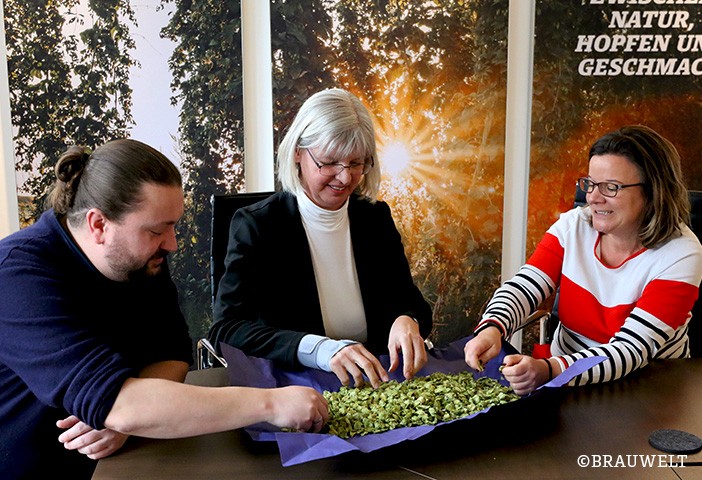It is well known that climate affects the crop yield and the alpha acid content of the hops. In hot, dry summers, for example, the bitter substance yield drops by up to 70 percent compared to "normal" summers. How aroma substances and polyphenols of hops change in relation to weather, especially in Germany, was not known until recently. An extensive study by Adrian Forster, Florian Schüll and Johann Bertazzoni, published in December in the Hop Special of the journal Brewing Science, provides new groundwork for this pressing issue. Growers and brewers can use the findings to adjust specifically to fluctuating weather patterns and crop qualities.
Interesting Findings
German landraces, flavor-forward new varieties and classic varieties used for bitterness from two climatically different crop years were examined. The scientists analyzed just about everything that can be measured: Alpha acid, beta acid, xanthohumol, polyphenols as well as the total oil content and individual hop oil fractions.
The results are insightful: Climate has a particularly strong influence on landraces such as Hersbrucker or Hallertauer Mittelfrüh. These landraces show poorer results under hot and dry weather conditions - not only for alpha acid but also for oil content across all substance groups. Younger varieties such as Mandarina Bavaria prove to be much more stable. Most likely due to the fact that American varieties, which cope with high temperatures and less water, have been crossed into these new varieties.
Interestingly, the bitter varieties Magnum, Taurus and Herkules show more resistance than their ancestors, the old landraces. These classic bitter varieties have no American ancestors. Their resistance is rather a credit to German hop breeding that has successfully been breddingfor better tolerances.
Who is affected?
Accordingly, climate-related deficits primarily affect brewers who produce German beer styles based on classic German hop varieties. They are particularly challenged to keep the quality and taste of their products constant year after year.
For them, it is worth taking a closer look at the analysis data: As far as aroma is concerned, sesquiterpenes and humulene responsible for the typical spicy, woody and grassy base aroma, prove to be relatively stable in the landraces.
However, substances such as linalool, geraniol and myrcene hardly survive. They contribute subtle citrussy and floral notes that we appreciate in Hersbrucker, for example. In a crop with a 40-50 percent drop in these substance groups these flavors can hardly be reproduced. With regards to the new flavor-forward varieties, we see much less ofthese negative tendencies. But what always gets lost are the esters, which are important for fruitiness.
What can brewers do?
What can brewers do? - They certainly will not be able to measure relevant substance groups every year – it would be far too time-consuming and expensive. In addition, analytical values of individual substance groups indicate a tendency, but do not prove anything about the actual aromatic expression.
That's why the Brewing Solutions Team at BarthHaas always recommends carrying out a sensory analysis and evalutating whether the hops correspond to a desired flavor.. Based on such an analysis, one can then look for suitable solutions. For example, with landraces it is often sufficient to increase the dosage accordingly. The total oil content can be used as a guideline for the dosage.
In the case of the new varieties with a flavor-forward fruity character, we advise to determine sensorially whether the crop is capable of reproducing the desired aromas at all. Since these varieties are usually used in the cold sectorto impart a distinctive character to the beer, there are two alternatives: selecting a new variety combination that corresponds to the desired aroma profile or resorting to standardized products.
In order to avoid crop fluctuations, enriched pellets containing either a standardized aroma expression (hop blends) or alpha content (classic T45) are a good choice within the Reinheitsgebot from the large portfolio of hop products. These pellets also have the advantage of keeping polyphenols under control. The higher the enrichment, the lower the proportion of plant substances and thus the polyphenol content.
In addition, hop blending is another method of choice - especially when the hop aroma of a beer is particularly significant, for example as a unique selling point or trademark. In blending, hop varieties are combined so that they correspond to a defined aroma profile. Such an aroma profile can be created, for example, on the basis of retention samples.
Conclusions for the future
All in all, climate change, which brings extremely different weather conditions from year to year, means that brewers have to look more closely at their hops and the varieties. As we know, a lot is being done on the part of hop research, not least to keep the German hop-growing regions fit for the future. The brewers, however, must follow suit and continue their education. They need to know which aroma profiles they are looking for and flexibly adapt to them each year in the process and in the choice of hops and products.
Initial guidance is provided by the Harvest Guide providing the crop-specific aroma profiles of the most important hop varieties published by BarthHaas annually. In addition, the BarthHaas Brewing Solutions Team offers a comprehensive service and is happy to advise and accompany brewers in finding suitable solutions for consistent quality - for example, in creating aroma profiles and custom-made hop blends. Finally, the BarthHaas Hops Academy offers an extensive training program: From individual courses to the renowned five-part Hop Flavorist Master-Program.
Reference: „The impact of climatic conditions on the biogenesis of various compounds in hops”, Brewing Science Nov-Dec 2021 (Vol. 74), A. Forster, A. Gahr, F. Schüll, J. Bertazzoni.





